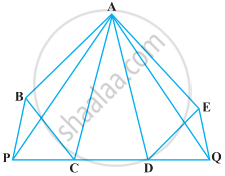Advertisements
Advertisements
Question
In the given figure, diagonals AC and BD of quadrilateral ABCD intersect at O such that OB = OD. If AB = CD, then show that:
(i) ar (DOC) = ar (AOB)
(ii) ar (DCB) = ar (ACB)
(iii) DA || CB or ABCD is a parallelogram.
[Hint: From D and B, draw perpendiculars to AC.]

Solution
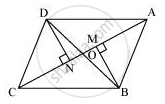
Let us draw DN ⊥ AC and BM ⊥ AC.
(i) In ΔDON and ΔBOM,
∠DNO = ∠BMO (By construction)
∠DON = ∠BOM (Vertically opposite angles)
OD = OB (Given)
By AAS congruence rule,
ΔDON ≅ ΔBOM
∴ DN = BM ... (1)
We know that congruent triangles have equal areas.
∴ Area (ΔDON) = Area (ΔBOM) ... (2)
In ΔDNC and ΔBMA,
∠DNC = ∠BMA (By construction)
CD = AB (Given)
DN = BM [Using equation (1)]
∴ ΔDNC ≅ ΔBMA (RHS congruence rule)
⇒ Area (ΔDNC) = Area (ΔBMA) ... (3)
On adding equations (2) and (3), we obtain
Area (ΔDON) + Area (ΔDNC) = Area (ΔBOM) + Area (ΔBMA)
Therefore, Area (ΔDOC) = Area (ΔAOB)
(ii) We obtained,
Area (ΔDOC) = Area (ΔAOB)
⇒ Area (ΔDOC) + Area (ΔOCB) = Area (ΔAOB) + Area (ΔOCB)
(Adding Area (ΔOCB) to both sides)
⇒ Area (ΔDCB) = Area (ΔACB)
(iii) We obtained,
Area (ΔDCB) = Area (ΔACB)
If two triangles have the same base and equal areas, then these will lie between the same parallels.
∴ DA || CB ... (4)
In ΔDOA and ΔBOC,
∠DOA = ∠BOC (Vertically opposite angles)
OD = OB (Given)
∠ODA = ∠OBC (Alternate opposite angles)
By ASA congruence rule,
ΔDOA ≅ ΔBOC
∴ DA = BC ... (5)
In quadrilateral ABCD, one pair of opposite sides is equal and parallel (AD = BC)
Therefore, ABCD is a parallelogram.
APPEARS IN
RELATED QUESTIONS
In the given figure, E is any point on median AD of a ΔABC. Show that ar (ABE) = ar (ACE)
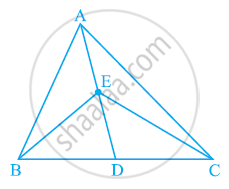
Show that the diagonals of a parallelogram divide it into four triangles of equal area.
In the given figure, ABC and ABD are two triangles on the same base AB. If line-segment CD is bisected by AB at O, show that ar (ABC) = ar (ABD).
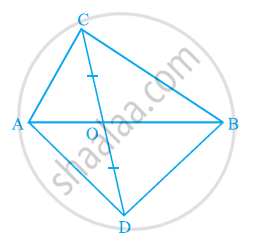
D, E and F are respectively the mid-points of the sides BC, CA and AB of a ΔABC. Show that
(i) BDEF is a parallelogram.
(ii) ar (DEF) = 1/4ar (ABC)
(iii) ar (BDEF) = 1/2ar (ABC)
In the following figure, D and E are two points on BC such that BD = DE = EC. Show that ar (ABD) = ar (ADE) = ar (AEC).
Can you answer the question that you have left in the ’Introduction’ of this chapter, whether the field of Budhia has been actually divided into three parts of equal area?
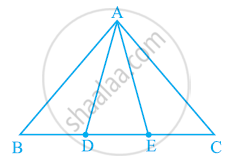
[Remark: Note that by taking BD = DE = EC, the triangle ABC is divided into three triangles ABD, ADE and AEC of equal areas. In the same way, by dividing BC into n equal parts and joining the points of division so obtained to the opposite vertex of BC, you can divide ΔABC into n triangles of equal areas.]
In the following figure, ABC is a right triangle right angled at A. BCED, ACFG and ABMN are squares on the sides BC, CA and AB respectively. Line segment AX ⊥ DE meets BC at Y. Show that:-
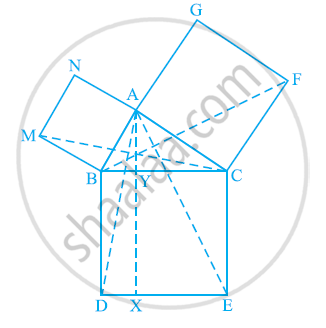
(i) ΔMBC ≅ ΔABD
(ii) ar (BYXD) = 2 ar(MBC)
(iii) ar (BYXD) = ar(ABMN)
(iv) ΔFCB ≅ ΔACE
(v) ar(CYXE) = 2 ar(FCB)
(vi) ar (CYXE) = ar(ACFG)
(vii) ar (BCED) = ar(ABMN) + ar(ACFG)
Note : Result (vii) is the famous Theorem of Pythagoras. You shall learn a simpler proof of this theorem in Class X.
In a ΔABC, P and Q are respectively the mid-points of AB and BC and R is the mid-point
of AP. Prove that :
(1) ar (Δ PBQ) = ar (Δ ARC)
(2) ar (Δ PRQ) =`1/2`ar (Δ ARC)
(3) ar (Δ RQC) =`3/8` ar (Δ ABC) .
The area of the parallelogram ABCD is 90 cm2 (see figure). Find ar (ΔABD)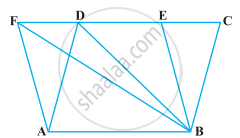
O is any point on the diagonal PR of a parallelogram PQRS (Figure). Prove that ar (PSO) = ar (PQO).
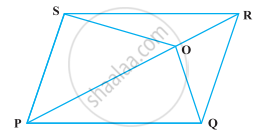
In the following figure, ABCDE is any pentagon. BP drawn parallel to AC meets DC produced at P and EQ drawn parallel to AD meets CD produced at Q. Prove that ar (ABCDE) = ar (APQ)
